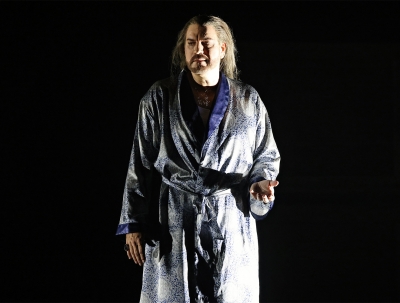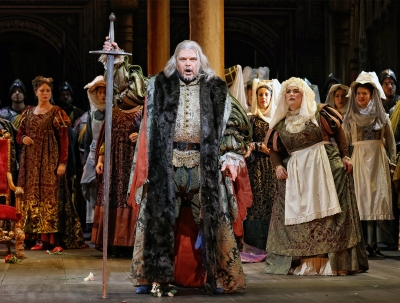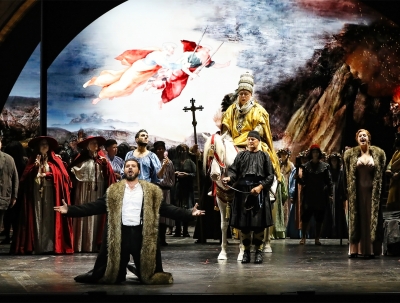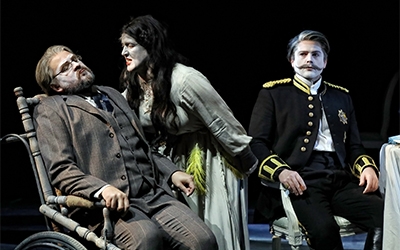Opera Australia
Sign up to From the Archive and receive a new review to your inbox every Monday. Always free to read.
Recent:
Béla Bartók’s Duke Bluebeard’s Castle was premièred amid the chaotic, final months of the Great War. Its lugubrious symphonic mood, grim libretto, and static set gained respect rather than favour from its first anxious audience. A century on, now freed from the shackles of copyright (Bartók died in 1945), the opera invites new approaches, arrangements, and settings. There is even now an annual Hungarian opera festival, where the Duke and his latest wife are presented everywhere from night bars to spa baths.
... (read more)George Bernard Shaw tartly suggested that ‘the chief glory of Victor Hugo as a stage poet was to have provided libretti for Verdi’. Hugo’s fifteen dramas are not well known in the English-speaking world and live on mainly through the many operatic reincarnations of the plays. Most prominent in popular culture, though, is the adaptation of Hugo’s novel Les Misérables, the blockbuster musical. The first successful operatic adaptation of a play was Gaetano Donizetti’s Lucrezia Borgia of 1833, which introduced a strong strain of realism into Italian opera. Undoubtedly the most successful of all the Hugo operas is Rigoletto (1851), Verdi’s version of Le roi s’amuse, still one of the most performed operas in the repertoire. Hugo later admitted that the opera was ‘better’ than the play.
... (read more)The fearsome figure of Attila the Hun (406–53 CE) has always had a bad press, yet in Verdi’s opera of 1846 he emerges as the most sympathetic and nuanced character of a group of three other rather unlikeable, two-dimensional principals, all of whom plot his final demise. During the course of the opera, Attila emerges as a somewhat naïve, trusting character, and shows great respect for his avowed enemy, the Roman general Ezio. Yet it does not end happily for Attila, ultimately done in by the three of them; almost certainly not a historically accurate depiction.
... (read more)Gale Edwards’s production of La Bohème is back for an extended summer season – sixteen performances no less. This production has been filling theatres since its creation in 2011. It may not run for as long as Franco Zeffirelli’s 1981 extravaganza, still an annual fixture at the Metropolitan Opera, but it probably has another good decade to go. Revived here by Liesel Badorrek, it works considerably better in the tiny Joan Sutherland Theatre than it did in the State Theatre in 2018; the latter is too palatial for bohemian confinement and privations.
... (read more)Reviewing the recent production of Madama Butterfly in Adelaide, I dwelt on Giacomo Puccini’s ceaseless search for new subjects between operas and how he considered everything from a Zola novel to the historical Marie Antoinette before settling on the story of Cio-Cio San.
... (read more)The recent speech by young Swedish climate-change activist Greta Thunberg has provoked much comment and controversy. It also caused me to ponder the future of our planet and how our cultural lives will be affected by the environmental changes that will inevitably take place by the middle of the twenty-first century ...
... (read more)A few years before he wrote his play The Ghost Sonata (1907), August Strindberg bitterly observed: ‘Life is so horribly ugly, we human beings so abysmally evil, that if a writer were to depict all that he had seen and heard no one could bear to read it ... Breeding and education seem only to mask the beast in us, and virtue is a disguise ...
... (read more)A few weeks after that memorable Peter Grimes from the Sydney Symphony Orchestra, Sydney and Melbourne ...
Unlike the many films about the lives of artists, operas in which visual artists feature are few, though two of the most popular in the repertoire, Puccini’s Tosca and La Bohème, both have painters as central characters. The lives of artists are often messy affairs and resist convenient shaping into narrative arcs, with the actual creative process difficult to dramatise effectively ...
... (read more)Opera Australia – in its present expansionary phase – has hitched its wagon to a digital star in the form of a series of seven-metre-high LED screens. The future moves about on a busy automation system, thus creating a series of new dramatic spaces. Interviewed in the July 2019 issue of Opera magazine, Lyndon Terracini ...
... (read more)










